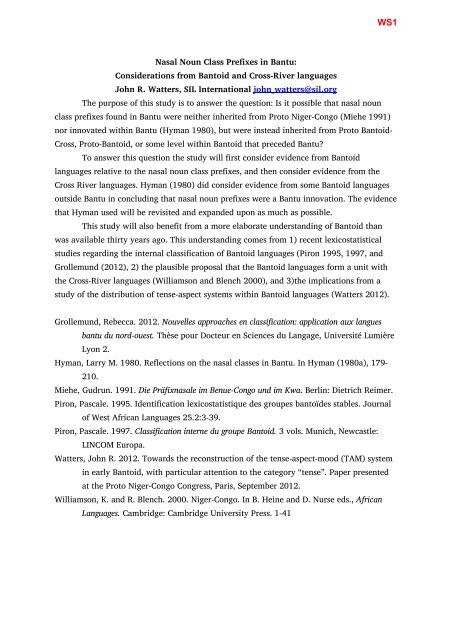here - 5th International Conference on Bantu Languages
here - 5th International Conference on Bantu Languages
here - 5th International Conference on Bantu Languages
You also want an ePaper? Increase the reach of your titles
YUMPU automatically turns print PDFs into web optimized ePapers that Google loves.
Nasal Noun Class Prefixes in <strong>Bantu</strong>:<br />
C<strong>on</strong>siderati<strong>on</strong>s from Bantoid and Cross-River languages<br />
John R. Watters, SIL <str<strong>on</strong>g>Internati<strong>on</strong>al</str<strong>on</strong>g> john_watters@sil.org<br />
The purpose of this study is to answer the questi<strong>on</strong>: Is it possible that nasal noun<br />
class prefixes found in <strong>Bantu</strong> were neither inherited from Proto Niger-C<strong>on</strong>go (Miehe 1991)<br />
WS1<br />
nor innovated within <strong>Bantu</strong> (Hyman 1980), but were instead inherited from Proto Bantoid-<br />
Cross, Proto-Bantoid, or some level within Bantoid that preceded <strong>Bantu</strong>?<br />
To answer this questi<strong>on</strong> the study will first c<strong>on</strong>sider evidence from Bantoid<br />
languages relative to the nasal noun class prefixes, and then c<strong>on</strong>sider evidence from the<br />
Cross River languages. Hyman (1980) did c<strong>on</strong>sider evidence from some Bantoid languages<br />
outside <strong>Bantu</strong> in c<strong>on</strong>cluding that nasal noun prefixes were a <strong>Bantu</strong> innovati<strong>on</strong>. The evidence<br />
that Hyman used will be revisited and expanded up<strong>on</strong> as much as possible.<br />
This study will also benefit from a more elaborate understanding of Bantoid than<br />
was available thirty years ago. This understanding comes from 1) recent lexicostatistical<br />
studies regarding the internal classificati<strong>on</strong> of Bantoid languages (Pir<strong>on</strong> 1995, 1997, and<br />
Grollemund (2012), 2) the plausible proposal that the Bantoid languages form a unit with<br />
the Cross-River languages (Williams<strong>on</strong> and Blench 2000), and 3)the implicati<strong>on</strong>s from a<br />
study of the distributi<strong>on</strong> of tense-aspect systems within Bantoid languages (Watters 2012).<br />
Grollemund, Rebecca. 2012. Nouvelles approaches en classificati<strong>on</strong>: applicati<strong>on</strong> aux langues<br />
bantu du nord-ouest. Thèse pour Docteur en Sciences du Langage, Université Lumière<br />
Ly<strong>on</strong> 2.<br />
Hyman, Larry M. 1980. Reflecti<strong>on</strong>s <strong>on</strong> the nasal classes in <strong>Bantu</strong>. In Hyman (1980a), 179-<br />
210.<br />
Miehe, Gudrun. 1991. Die Präfixnasale im Benue-C<strong>on</strong>go und im Kwa. Berlin: Dietrich Reimer.<br />
Pir<strong>on</strong>, Pascale. 1995. Identificati<strong>on</strong> lexicostatistique des groupes bantoïdes stables. Journal<br />
of West African <strong>Languages</strong> 25.2:3-39.<br />
Pir<strong>on</strong>, Pascale. 1997. Classificati<strong>on</strong> interne du groupe Bantoid. 3 vols. Munich, Newcastle:<br />
LINCOM Europa.<br />
Watters, John R. 2012. Towards the rec<strong>on</strong>structi<strong>on</strong> of the tense-aspect-mood (TAM) system<br />
in early Bantoid, with particular attenti<strong>on</strong> to the category “tense”. Paper presented<br />
at the Proto Niger-C<strong>on</strong>go C<strong>on</strong>gress, Paris, September 2012.<br />
Williams<strong>on</strong>, K. and R. Blench. 2000. Niger-C<strong>on</strong>go. In B. Heine and D. Nurse eds., African<br />
<strong>Languages</strong>. Cambridge: Cambridge University Press. 1-41


